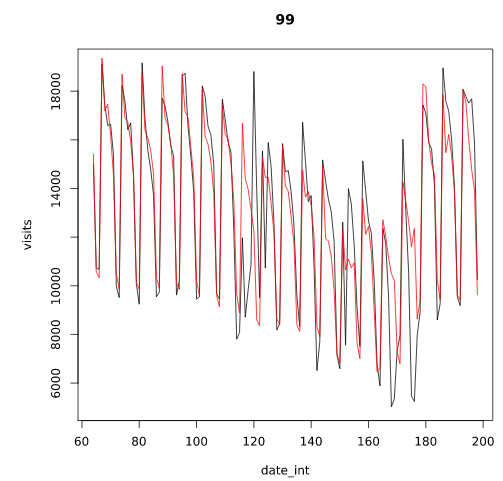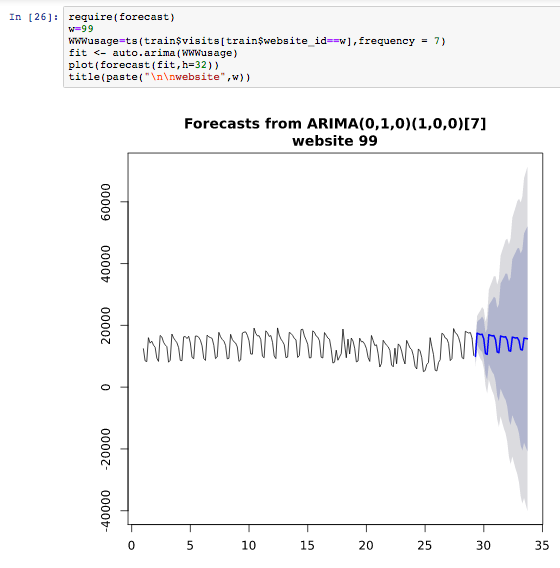If you want to get some insight on how autoregression works, I wrote this code:
w=99
train = read.csv("/tmp/trainData.csv", header = TRUE)
train=train[train$website_id==w,]
repair=function(x) { if(length(x)==0) return(NA); return(x);}
for(b in seq(7*5,7*9,7)){
train[[paste0('backshift',b)]]=rep(NA,nrow(train))
for(r in 1:nrow(train)){ #slow way to do this
train[r,paste0('backshift',b)]=repair(train$visits[train$website_id==train[r,'website_id']
& train$date_int==(train[r,'date_int']-b)])
}
}
train=train[complete.cases(train),]
rmse=function(x,y,k=0){
return( sqrt(sum((x-y)^2)/(length(x)-k)))
}
require(MASS)
train$months <- as.factor(train$month)
train$date=NULL
model<-glm(visits ~. , train, family=poisson)
model=stepAIC(model,trace=F)
summary(model)
P = predict(model, newdata = train, type = "response")
imp = round(P)
rmse(imp,train$visits)
train$fit=imp
with(train[train$website_id==w,],{
plot(date_int,visits,type='l')
points(date_int,fit,col='red',type='l')
title(w)
})
Here is the poisson model:
Call:
glm(formula = visits ~ date_int + D1 + D2 + D3 + D4 + D5 + D6 +
backshift35 + backshift42 + backshift49 + backshift56 + backshift63 +
months, family = poisson, data = train)
Deviance Residuals:
Min 1Q Median 3Q Max
-72.386 -4.389 1.126 6.912 54.939
Coefficients:
Estimate Std. Error z value Pr(>|z|)
(Intercept) 1.003e+01 2.405e-02 416.935 < 2e-16 ***
date_int -3.380e-03 1.125e-04 -30.044 < 2e-16 ***
D1 -4.000e-02 3.425e-03 -11.680 < 2e-16 ***
D2 7.957e-01 9.623e-03 82.686 < 2e-16 ***
D3 6.755e-01 8.258e-03 81.800 < 2e-16 ***
D4 6.502e-01 7.997e-03 81.299 < 2e-16 ***
D5 5.791e-01 7.470e-03 77.530 < 2e-16 ***
D6 4.544e-01 6.173e-03 73.602 < 2e-16 ***
backshift35 9.173e-06 5.502e-07 16.671 < 2e-16 ***
backshift42 -1.368e-05 5.191e-07 -26.353 < 2e-16 ***
backshift49 1.408e-06 5.656e-07 2.489 0.01280 *
backshift56 -2.305e-05 6.010e-07 -38.358 < 2e-16 ***
backshift63 1.957e-06 6.035e-07 3.242 0.00119 **
months9 -3.231e-01 1.332e-02 -24.258 < 2e-16 ***
months10 -2.589e-01 1.070e-02 -24.192 < 2e-16 ***
months11 -2.907e-01 7.710e-03 -37.706 < 2e-16 ***
months12 -3.915e-01 4.577e-03 -85.529 < 2e-16 ***
---
Signif. codes: 0 ‘***’ 0.001 ‘**’ 0.01 ‘*’ 0.05 ‘.’ 0.1 ‘ ’ 1
(Dispersion parameter for poisson family taken to be 1)
Null deviance: 157970 on 134 degrees of freedom
Residual deviance: 39894 on 118 degrees of freedom
AIC: 41448
Number of Fisher Scoring iterations: 4
You can try different values of website_id (w). I had backshift start at 5 weeks ago which allows you to easily forecast 5 weeks, but you can forecast farther than that by making predictions based on predictions.


